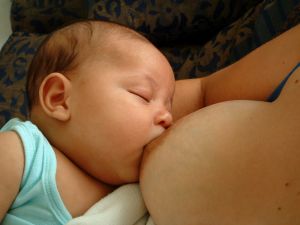By Lance Hugh
 Breast augmentation is one of the most common cosmetic surgeries, accounting for more than 300,000 procedures per year. The average implant patient is in her mid-30s and has already had a child, but many women also receive augmentation surgery at a younger age. Breast implants can interfere with breastfeeding if the procedure is performed incorrectly, but they don’t have to.
Breast augmentation is one of the most common cosmetic surgeries, accounting for more than 300,000 procedures per year. The average implant patient is in her mid-30s and has already had a child, but many women also receive augmentation surgery at a younger age. Breast implants can interfere with breastfeeding if the procedure is performed incorrectly, but they don’t have to.
Human lactation starts in the late part of pregnancy. The breasts begin to produce colostrum, a special type of early milk, but are prevented from excreting it until after birth. After a child is born, the mother’s hormone levels adapt, causing the breasts to fill with milk.
The milk is produced by the lactiferous ducts, which are located mostly around the nipple. These ducts drain into the nipple, where the milk is released for breastfeeding. Implants can theoretically interfere with this process if their filler leaks into the milk, if the implanting process damaged the milk ducts or nerves, or if the implant puts too much pressure on the milk ducts.
In a study of 46 new mothers at the University of Texas, 39% of those who chose to breastfeed suffered from difficulties. About 72% of those women’s problems were related to their implants. Some women had breastfeeding difficulties unrelated to their past breast augmentation. Out of the women who did have implant-related trouble, the majority had received their implants via an incision around the nipple. This procedure is most likely to damage the milk ducts or related structures, although 61% of the women who chose to breastfeed suffered no interference despite their implants. Some women assumed that their implants would automatically interfere with lactation and chose not to attempt breastfeeding.
The easiest way to prevent implants from interfering with breastfeeding later in life is to choose moderately sized prostheses and to avoid peri-areolar incisions. Patients should realize that large implants or surgical procedures that damage the breast structure can completely prevent them from breastfeeding in some cases. Women who have previously received implants or who are thinking about the procedure should take the time to talk to their surgeons about the potential side effects.
General practitioners may not have the knowledge required to provide accurate advice, so it’s best to choose a board-certified plastic surgeon or a professional lactation consultant. These people have the background to provide useful advice to patients who do suffer from breastfeeding problems due to their implants. They may be able to help new mothers find new, more effective feeding techniques.
I had implants years before I had my son. I did not have any difficulties breast feeding at all. My implants were placed behind the muscle and I went up two cup sizes. The key for my not having complications was how my procedure was done. My doctor made an incision at my navel and inserted the implants in via a tube from the navel.
I also previously had breast augmentation w/inframammary incisions & experienced no difficulty breastfeeding. I would note that alteration in nipple sensation can alter the ability to breastfeed. That’s another increased risk of larger implants. I would be interested to know if axillary incions have equal success w/breastfeed s/p breast aug. I would strongly encourage any woman to atleast try to breastfeed after their aug.
Hey, I’m considering having breast augmentation surgery. My question is about having under muscle as I am extremely active meaning that I like to keep fit. Does anyone have any recommendations? I have not seen the surgeon as I’m still not quite ready for the procedure. Thanks